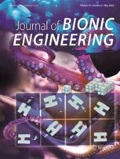Abstract
A novel bionic swarm intelligence algorithm, called ant colony algorithm based on a blackboard mechanism, is proposed to solve the autonomy and dynamic deployment of mobiles sensor networks effectively. A blackboard mechanism is introduced into the system for making pheromone and completing the algorithm. Every node, which can be looked as an ant, makes one information zone in its memory for communicating with other nodes and leaves pheromone, which is created by ant itself in nature. Then ant colony theory is used to find the optimization scheme for path planning and deployment of mobile Wireless Sensor Network (WSN). We test the algorithm in a dynamic and unconfigurable environment. The results indicate that the algorithm can reduce the power consumption by 13% averagely, enhance the efficiency of path planning and deployment of mobile WSN by 15% averagely.
Similar content being viewed by others
References
Kumar S, Lai T H, Arora A. Barrier coverage with wireless sensors. Proceedings of the 7th Annual International Conference on Mobile Computing and Networking (MobiCom), Cologne, Germany, 2005, 284–298.
Mysorewala M F, Popa D O, Giordano V, Lewis F L. Deployment algorithms and in-door experimental vehicles for studying mobile wireless sensor networks. The Seventh ACIS International Conference on Software Engineering, Artificial Intelligence, Networking, and Parallel/Distributed Computing, Washington DC, USA, 2006, 290–298.
Seovv C K, Seah W K G, Liu Z. Hybrid mobile wireless sensor network cooperative localization. The 22nd IEEE International Symposium on Intelligent Control, Singapore, 2007, 29–34.
Chang R S, Wang S H. Deploying sensors for maximum coverage in sensor networks. Proceedings of the 2007 International Conference on Wireless Communications and Mobile Computing, Honolulu, Hawaii, USA, 2007, 220–224.
Brass P. Bounds on coverage and target detection capabilities for models of networks of mobile sensors. ACM Transactions on Sensor Networks, 2007, 3, 1–19.
Ding N N, Liu P X. A centralized approach to energy-efficient protocols for wireless sensor networks. IEEE International Conference on Mechatronics and Automation, Niagara Falls, Canada, 2005, 1636–1641.
Okdem S, Karaboga D. Routing in wireless sensor networks using ant colony optimization. The First NASA/ESA Conference on Adaptive Hardware and Systems, Istanbul, Turkey, 2006, 401–404.
Kulatunga A K, Liu D K, Dissanayake G, Siyambalapitiya S B. Ant colony optimization based simultaneous task allocation and path planning of autonomous vehicles. IEEE Conference on Cybernetics and Intelligent System, Bangkok, Thailand, 2006, 1–6.
Iyengar S S, Wu H C, Balakrishnan N, Chang S Y. Biologically inspired cooperative routing for wireless mobile sensor networks. IEEE System Journal, 2007, 1, 29–37.
Wang L, Zhang Q, Wan N. Simulation study on searching for food by cooperation of multi-robots with swarm intelligence. Proceedings of the IEEE International Conference on Automation and Logistics, Jinan, China, 2007, 2296–3000.
Lv N, Feng Z R. Numerical potential field and ant colony optimization based path planning in dynamic environment. Proceedings of the 6th World Congress on Intelligent Control and Automation, Dalian, China, 2006, 8966–8970.
Wu C H, Lee K C, Chung Y C. A delaunay triangulation based method for wireless sensor network deployment. Proceedings of the 12th International Conference on Parallel and Distributed Systems, Minneapolis, USA, 2006, 253–260.
Chang C Y, Chang H R, Hsieh C C, Chang C T. OFRD: Obstacle-free robot deployment algorithm for wireless sensor networks. Proceedings of the IEEE Wireless Communications and Networking Conference, Hongkong, 2007, 4374–4379.
Colorni A, Dorigo M, Maniezzo V. Distributed optimization by ant colonies. Proceedings of the 1st European Conference on Artificial Life, Paris, France, 1991, 134–142.
Fan X, Luo X, Yi S, Yang S Y, Zhang H. Optimal path planning for mobile robots based on intensified ant colony optimization algorithm. Proceedings of the 2003 IEEE International Conference on Robotics, Intelligent Systems and Signal Processing, Changsha, China, 2003, 131–136.
Yang S H, Li M L, Wu J. Scan-based movement-assisted sensor deployment methods in wireless sensor networks. IEEE Transaction on Parallel and Distributed Systems, 2007, 18, 1108–1121.
Machado R, Tekinay S. Bounds on the error in estimating redundancy in randomly deployed wireless sensor networks. Proceedings of the International Conference on Sensor Technologies and Applications, Valencia, Spain, 2007, 319–324.
Author information
Authors and Affiliations
Corresponding author
Rights and permissions
About this article
Cite this article
Qi, Gp., Song, P. & Li, Kj. Blackboard Mechanism Based Ant Colony Theory for Dynamic Deployment of Mobile Sensor Networks. J Bionic Eng 5, 197–203 (2008). https://doi.org/10.1016/S1672-6529(08)60025-6
Published:
Issue Date:
DOI: https://doi.org/10.1016/S1672-6529(08)60025-6




